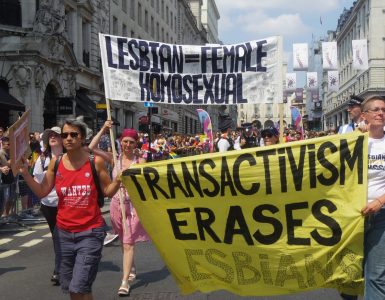Following the publication of the Transgender Equality Report, the UK government intends to consult on amending the Gender Recognition Act. This will have significant impacts on both trans people and others, especially women, children, and the lesbian and gay community. Please read our Fact Sheet for more.
SAGES Publications
Quick Facts Sex, Gender and Equal Rights PDF
Fact Sheet
Sex, Gender and Equal Rights
Definitions
- Gender means socially constructed roles, characteristics, and behaviours: for example, women may be seen as empathic and suited to caring roles, while men may be seen as logical, tough, and suited to technical jobs.
- Sex refers to biological and physiological characteristics: for example, men have penises, women have vaginas. In Britain, the terms “male” and “female” are used on birth certificates to show a person’s sex. In everyday language and some legislation, the words “sex” and “gender” are often used interchangeably. However, in other legislation and in research literature, sex and gender are considered separately. In this information sheet, we use “male” and “female” to refer to birth sex. We use “woman” to mean someone whose birth sex is female. We use “trans-identifying male” to mean a trans person whose birth sex is male (they may call themselves a woman, trans woman, transsexual, or non-binary person, for example).
- Gender reassignment is the process of transitioning from one gender to another. A small proportion of trans-identifying people have medical treatment (hormones, surgery, or both),2 and many change their appearance, but these changes are not obligatory.3 It is impossible to change sex, even with medical treatment. Rather, a trans-identifying male who lives as a woman identifies with the feminine gender role.
- Gender identity is a person’s internal sense of their own gender, whether or not it aligns with societal norms.
- Gender dysphoria is the medical term for the condition in which a person experiences distress because they identify as having a gender that is different from their recorded birth sex.
The current law
- Sex and gender reassignment are both protected characteristics under the Equality Act 2010.
- Under the Gender Recognition Act 2004, someone wishing to change their legal gender can apply for a Gender Recognition Certificate. They must have lived as the acquired gender for two years and must have been given a medical diagnosis of gender dysphoria, but medical treatment is not required.
Proposed changes to the law
The Transgender Equality Report1 made the following recommendations (among others):
- Self-declaration. To make legal gender changes easier for trans-identifying people, the need for a medical diagnosis should be removed. Gender Recognition Certificates should be issued through a simple administrative process of self-declaration of gender identity. This would apply to adults and 16/17-year-olds.
- The protected characteristic of “gender reassignment” in the Equality Act 2010 should be changed to “gender identity”.
- No exclusion of trans people under any circumstances. A person with a Gender Recognition Certificate should never be excluded from a single-sex occupation or service for people of their acquired gender.
What does this mean in practice?
Currently, organisations offering single-sex services in sensitive situations may exclude people of the opposite birth sex if it is a proportionate means of achieving a legitimate aim.3 4 For example, a service for women who have experienced sexual assault could exclude a person who has transitioned to live as a woman from working as a therapist or accessing a women’s therapy group there.
Under the new recommendations, this would no longer be the case. A male person could legally change their gender to “woman” or “female” by self-declaration – no medical diagnosis of gender dysphoria or other assessment would be required, and they would not need to change anything about themselves, such as changing appearance or having medical treatment. This person would then be eligible to attend or work at the women-only therapy service in our example.1
The UK trans community
- The UK trans population is estimated to be about 650,000 people (1 in 100),2 but only a few have Gender Recognition Certificates.
- As of 2015, about 5% of trans-identifying people in the UK had sought medical treatment. Eventually, about 20% are expected to do so.2
- The number of people with gender dysphoria is much smaller than the number of trans-identifying people. About 1 in 14,700 adult males and 1 in 38,500 adult females have gender dysphoria.5
- If gender dysphoria is removed as a requirement for legally changing gender, many more trans-identifying people will have the option of taking this step and accessing sensitive single-sex services.
Impacts on women and girls
Women-only spaces
- Three quarters of violent crimes6 and 98% of sexual offences7 are committed by males.
- Sex-segregation exists to provide safety and dignity where women are physically and sexually vulnerable.
- The proposed changes would allow trans-identifying males to access woman-only spaces such as changing rooms, refuges, hospital wards, prisons, and shared sleeping arrangements, with no exceptions.
- 80–95% of these trans-identifying males will not have had any medical treatment as part of their transition.2
- Referrals to gender identity services of prisoners convicted of serious sexual offences vastly outnumber referrals of prisoners convicted of non-sexual offences.8
- Women and girls will be told it is a hate crime to complain about trans-identifying males in their changing rooms.9
Intimate care and contact
- Under the new proposals, disabled and elderly women who prefer a female carer for washing, dressing, and so on won’t be sure of getting one.
- Women who want to see a female professional for intimate care such as bra fittings or gynaecological issues like smear tests, mammograms, contraception, pregnancy and birth may find this harder to arrange, too.
- Trans-identifying male police and security officials may perform intimate body searches on women.
Therapy
- 97% of women surveyed think that women should have the choice of accessing a woman-only support service if they have been the victim of sexual assault.10
- Under the proposed legal changes, trans-identifying males will be able to work as counsellors in women-only services and join therapy groups for women who have survived sexual abuse and assault, rape, and domestic violence.
Discrimination
- Gathering accurate statistics is essential for monitoring crime, health, and discrimination and addressing inequalities.
- Women are often discriminated against because of their potential or perceived ability to bear children and have far higher rates of being sexually assaulted7 or trafficked for the sex industry.11 If we monitor gender-identity but ignore sex, we can’t tackle sex-based discrimination.
- Hiring quotas, scholarships, and awards for women exist to counter sex-based discrimination and to ensure that women’s voices are represented. Trans-identifying males are already receiving such awards and positions intended for women, and if the law changes, more are likely to do so.
Sports
- Trans-identifying males are already competing and winning medals in women’s sports.
- International Olympic Committee guidelines on gender categories in sports only set rules for testosterone.12 But men are 14 cm taller, on average, with 10% more lung capacity and stronger bones. These advantages are retained by trans-identifying males who have had medical treatment.
- In some schools and universities, trans-identifying children and young people can compete according to their gender-identity without having any medical treatment.
Impacts on children and young people
- Under the new proposals, single-sex schools, activities, clubs, and dormitories may no longer be available.
- If a person of the opposite sex cannot be challenged for being in a single-sex space, it becomes harder to teach children how to stay safe.
- There is no consensus among experts as to the best approach to treating childhood gender dysphoria.13 But children are already being taught about gender identity and transition as early as primary school, and parents are not being given the option to withdraw them from those lessons.
- Under-18s referrals to gender services have risen by 2000% in the last eight years,14 and there is evidence of social contagion.15
Impacts on the lesbian and gay community
- Lesbians and gay men are attracted to people on the basis of sex, not gender-identity. The new gender-identity laws may make it impossible for them to have single-sex events and organisations.
- Lesbians in particular are being bullied and accused of transphobia for wanting to partner only with females and not with males who identify as women,16 even when those males retain their penises.
- The majority of children with gender dysphoria are no longer dysphoric by adulthood, but a high proportion grow up to be same-sex attracted.17Homophobia is still widespread in the UK and is the second-most common motivator of hate crimes (after race).18 This suggests that in some cases homophobia may be motivating same-sex attracted people to transition or motivating parents to encourage their children to transition and therefore be seen as straight.
Impacts on trans-identifying people
- Accurate data are needed to monitor the wellbeing of trans-identifying people as a group, to offer appropriate health care and other services, and to tackle discrimination against trans people.
- If trans people are only recorded as the opposite gender, none of this will be possible.
- Scientific research in this field is still in its infancy and there is no expert consensus on the underlying causes of gender dysphoria.13 Growing numbers of people are seeking to reverse the process of transition,19 20 although not all changes can be reversed.
- Making the process of transitioning easier may increase the number of people who regret doing so. This is especially important when thinking about young, vulnerable people.
Crime
- Offences committed by trans-identifying males are being recorded as being committed by women. This distorts crime statistics and makes it harder to address underlying problems.
- In crime investigations, DNA shows birth sex, not gender-identity. Recording gender-identity in official records instead of sex will make it more difficult to solve crimes.
Free speech and language
- Language related to women’s reproductive functions and female anatomy is being changed to be inclusive of trans-identifying people. But female reproductive health is a key area in which women are often discriminated against, and it’s essential for them to be able to describe their female anatomy clearly, accurately, and scientifically.21
- The proposed legal changes will make the word “woman” meaningless. Women are adult female humans: members of the sex class able to bear children. If the law is changed, a “woman” will become “anyone who identifies as a woman”. This will not change material reality. The half of the population with the potential or perceived ability to bear children will still face discrimination because of their sex and will still need to organise together to talk about it. This will become very difficult if there is no word to describe them.22
References
- House of Commons Women and Equalities Committee. Transgender equality, first report of session 2015–16, 2016. ↩ ↩2 ↩3
- Reed T. Written evidence submitted by GIRES to the Transgender Equality Inquiry, 2015. ↩ ↩2 ↩3 ↩4
- Equality Act 2010 code of practice. Services, public functions and associations. Statutory Code of Practice. ↩ ↩2
- Whitfield L. How legislation protects women-only spaces and services: an overview, 2016. ↩
- Arcelus J et al. Systematic review and meta-analysis of prevalence studies in transsexualism. Eur. Psychiatry 30:807–815 (2015). DOI: 10.1016/j.eurpsy.2015.04.005 ↩
- Office for National Statistics (ONS), Overview of violent crime and sexual offences, 2017. ↩
- Ministry of Justice, Home Office & ONS. An overview of sexual offending in England and Wales, 2013. ↩ ↩2
- Barrett J. Written evidence submitted by British Association of Gender Identity Specialists to the Transgender Equality Inquiry, 2015. ↩
- Crown Prosecution Service (CPS). Lesbian, gay, bisexual and transgender hate crime. Schools project. ↩
- Women’s Resource Centre. Why women-only? The value and benefits of by women, for women services, 2007. ↩
- United Nations (UN). Human rights violations. ↩
- IOC consensus meeting on sex reassignment and hyperandrogenism, Nov. 2015. ↩
- Vrouenraets LJ et al. Early medical treatment of children and adolescents with gender dysphoria: an empirical ethical study. J. Adolesc. Health 57(4):367–373 (2015). DOI: 10.1016/j.jadohealth.2015.04.004 ↩ ↩2
- NHS. GIDS referrals figures for 2016/17. ↩
- Littman L. Rapid onset of gender dysphoria in adolescents and young adults: a descriptive study. J Adolesc Health 60(2):S83–S126 (2017). ↩
- Yardley M. The conflict between feminism and the transgender movement. Morning Star, 24 Dec 2014. ↩
- American Psychiatric Association (APA). Diagnostic and Statistical Manual of Mental Disorders, 5th Edition (DSM-5), 2013. ↩
- Corcoran H & Smith K. Hate crime, England and Wales, 2015/16, Statistical Bulletin 11/16, Home Office, 2016. ↩
- Stella C. Female detransition and reidentification: Survey results and interpretation, 2016. ↩
- Hurst G. Bath Spa University bars research into transgender surgery regrets. The Times, 23 Sept 2017. ↩
- Woman-Centered Midwifery. Open letter to MANA, 20 Aug 2015. ↩
- Tunks K. Sex matters. Morning Star, 9 Aug 2017. ↩







